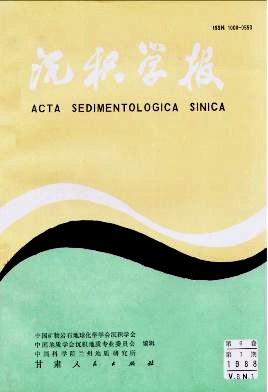DISCUSSION ON THE PALEOENVlRONMENT AND PALEOCLIMATE OF LOWER TERTIARY IN THE NORTH JIANGSU PETROLIFEROUS BASIN
- Received Date: 1986-02-18
- Publish Date: 1988-03-10
Abstract: The explorations for the sedimentary environment of Lower Tertiary in the North Jiangsu petroliferous basin are different. No consistent conclusion exists in these explroations. In order to f urther study the environment mentioned above, the approach used in this paper can avoid the conf usion of multisources of hydrocarbons and indicate directly the salinities of waters in which the carbonate deposits. In this study, the sedimental environment of this basin is defined by using the inorganic compounds in the sedimentary environment the δ13C and δ18O values for and other important evidences to identify the paleoenvironment and paleoclimate of Tertiary in the North Jiangsu basin. A diagram based on δ13C and δ18O values for members and formations of the basin is compared with Mook's Diagram (by Mook, 1971)of the δ13C / δ18O retionship and thesalinities in differnet waters.(Figs. 1,2).The comparison shows that most of the values fall in the area of lacustrine and fluvial environments in Mook's Diagram,only parts of the values of members Ef2 and Ef2 fall in the vicinity of marine environment. Another approach used in this study is the formula of Z datum (by Keith,1964),by which we can distinguish the marine-limestone from freshwater limestone.The calculated Z data of most members (Et, Ef1,Ef3 and Es1)are less than 120, only the data of members Ef2 and Ef4 are a little more than 120. Therefore they can be defined as a mixed type of limestone. Thirdly,the result, obtained bythe comparison of the δ13C values measured of this area with the δ18O for different environments defined by Degens, is good coincident with the results obtained above. Based on the above reasons, it can be concluded that the sedimentary paleoenvi-ronment of the basin is dominated by Iacustrine-fluvial facies. Only the intermittent marine transgressions during the two depositional periods of Ef2 and Ef4 resulted in the increase of salinities and the δ13C / δ18O values deviated from nonmarine environm-ent, but the values haven't reached the normal marine environment. It belongs to amixed sedimentary environment. The estimation for paleotemperature of the basin during the early Tertiary period is based on two approaches.One is the revised Craig Formula (1965).By the Craig Formula,the claculated mean annual paleotemperature of the basin is 21℃.The other is York's least square method (1969). Plotting the coordinates of calculated δ13C and δ18O values by using York's least square method on Mook's diagram for te-mper ature range (1971),we can obtain that the mean annual paleotemperature during that time is about 20 C.The two results agree with each other. Thirdly,according to the zonation of torrid zone and subtropical zone from "China's Vegetation" The paleoclimate of the basin during the early Tertiary should belong to south subtropi-cal zone. Thus,the mean annual paleotemperature at that time is estimated to be 21℃. The conclusions hereinabove also show good agreement with the evidences of paleontology.The fossils found in this area, such as calcareous super-microscopic fossils, ostracoda,foraminifera and spore-pollens, have fully confirmed the conclu-sions discussed in this paper.
| Citation: | Fei Fuan. DISCUSSION ON THE PALEOENVlRONMENT AND PALEOCLIMATE OF LOWER TERTIARY IN THE NORTH JIANGSU PETROLIFEROUS BASIN[J]. Acta Sedimentologica Sinica, 1988, 6(1): 21-28. |






 DownLoad:
DownLoad: